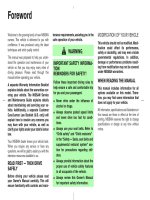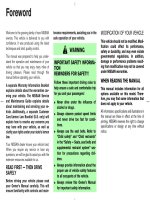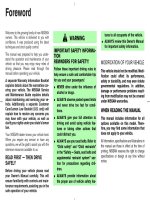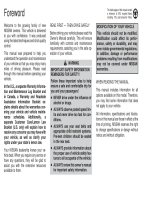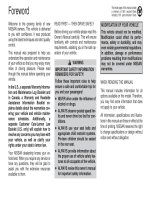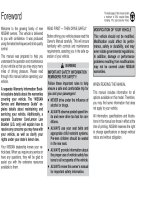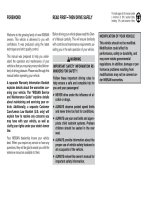NISSAN QUEST 2000 OWNER MANUAL SÁCH HƯỚNG dẫn sử DỤNG
Bạn đang xem bản rút gọn của tài liệu. Xem và tải ngay bản đầy đủ của tài liệu tại đây (2.48 MB, 292 trang )
Foreword
Welcome to the growing family of new
NISSAN owners. This vehicle is delivered
to you with confidence. It was produced
using the latest techniques and strict quality
control.
This manual was prepared to help you
understand the operation and maintenance
of your vehicle so that you may enjoy many
miles of driving pleasure. Please read
through this manual before operating your
vehicle.
In the U.S., a separate Warranty Informa-
tion and Maintenance Log Booklet and in
Canada, a Warranty and Roadside Assis-
tance Information Booklet explains de-
tails about the warranties covering your
vehicle and vehicle maintenance sched-
ules. Additionally, a separate Customer
Care/Lemon Law Booklet (U.S. only) will
explain how to resolve any concerns you
may have with your vehicle, as well as
clarify your rights under your state’s
lemon law.
Your NISSAN dealership knows your ve-
hicle best. When you require any service or
have any questions, they will be glad to
assist you with the extensive resources
available to them.
READ FIRST — THEN DRIVE SAFELY
Before driving your vehicle read this own-
er’s manual carefully. This will ensure famil-
iarity with controls and maintenance re-
quirements, assisting you in the safe
operation of your vehicle.
WARNING
IMPORTANT SAFETY INFORMATION
REMINDERS FOR SAFETY!
Follow these important driving rules to
help ensure a safe and comfortable trip
for you and your passengers!
● NEVER drive under the influence of
alcohol or drugs.
● ALWAYS observe posted speed lim-
its and never drive too fast for con-
ditions.
● ALWAYS use your seat belts and
appropriate child restraint
systems.
Pre-teen children should be seated
in the rear seat.
● ALWAYS provide information about
the proper use of vehicle safety fea-
tures to all occupants of the vehicle.
●
ALWAYS review this owner’s manual
for important safety information.
MODIFICATION OF YOUR VEHICLE
This vehicle should not be modified.
Modification could affect its perfor-
mance, safety or durability, and may
even violate governmental regulations.
In addition, damage or performance
problems resulting from modifications
may not be covered under NISSAN
warranties.
WHEN READING THE MANUAL
This manual includes information for all
options available on this model. Therefore,
you may find some information that does
not apply to your vehicle.
All information, specifications and illustra-
tions in this manual are those in effect at the
time of printing. NISSAN reserves the right
to change specifications or design without
notice and without obligation.
The inside pages of this manual contain
a minimum of 50% recycled fibers,
including 10% post-consumer fibers.
੬੭
You will see various symbols in this manual.
They are used in the following ways:
WARNING
This is used to indicate the presence of
a hazard that could cause death or
serious personal injury. To avoid or
reduce the risk, the procedures must
be followed precisely.
CAUTION
This is used to indicate the presence of
a hazard that could cause minor or
moderate personal injury or damage to
your vehicle. To avoid or reduce the
risk, the procedures must be followed
carefully.
If you see this symbol, it means ‘‘Do not do
this’’ or ‘‘Do not let this happen.’’
CALIFORNIA PROPOSITION 65
WARNING
WARNING
Engine Exhaust, some of its constitu-
ents, and certain vehicle components
contain or emit chemicals known to
State of California to cause cancer and
birth defects or other reproductive
harm.
© 2000 NISSAN NORTH AMERICA, INC.
GARDENA, CALIFORNIA
All rights reserved. No part of this Owner’s
Manual may be reproduced or stored in a
retrieval system, or transmitted in any form, or
by any means, electronic, mechanical, photo-
copying, recording or otherwise, without the
prior written permission of Nissan North
America, Inc., Gardena, California
The inside pages of this manual contain
a minimum of 50% recycled fibers,
including 10% post-consumer fibers.
APD1005
IMPORTANT INFORMATION
ABOUT THIS MANUAL
੬੭
Welcome To The World Of NISSAN
Your new NISSAN is the result of our dedication
to produce the finest in safe, reliable and eco-
nomical transportation. Your vehicle is the prod-
uct of a successful worldwide company that
manufactures cars and trucks in over 17 coun-
tries and distributes them in 170 nations.
NISSAN vehicles are designed and manufactured
by Nissan Motor Co., Ltd. which was founded in
Tokyo, Japan in 1933, and NISSAN affiliates world-
wide, collectively growing to become the fifth largest
automaker in the world. In addition to cars and
trucks, NISSAN also makes textile machinery, fork-
lift trucks, marine engines, boats and other products.
NISSAN has made a substantial and growing
investment in North America, starting with the
opening of Nissan Motor Corporation U.S.A. in
1960 and continuing with the production of some
cars and trucks at one of the world’s most
modern manufacturing facilities, Nissan Motor
Manufacturing Corporation U.S.A. in Smyrna,
Tennessee, vehicle styling at Nissan Design
International in San Diego, California, and engi-
neering at Nissan Research and Development in
Farmington Hills, Michigan.
NISSAN and its dealers indirectly employ about
60,000 Americans.
NISSAN is also a substantial contributor to the
Canadian economy. Nissan Canada Inc., its sup-
pliers and over 140 dealers employ approxi-
mately 4,500 people. These include company
employees and the staffs of NISSAN dealers all
across Canada. In addition, many Canadians
work for companies that supply NISSAN and
NISSAN dealers with materials and services
ranging from the operation of port facilities and
transportation services, to the supply of lubri-
cants, parts and accessories.
NISSAN pioneered the use of electronics and
computers in automobiles, and has led the indus-
try in improving both performance and fuel effi-
ciency through new engine designs and the use
of synthetic materials to reduce vehicle weight.
The company has also developed ways to build
quality into its vehicles at each stage of the
production process, both through extensive use
of automation and — most importantly —
through an awareness that people are the cen-
tral element in quality control.
From the time the parts arrived from our suppli-
ers until you took delivery of your new NISSAN,
dozens of checks were made to ensure that only
the best job was being done in producing and
delivering your vehicle. NISSAN also takes great
care to ensure that when you take your NISSAN
to yourdealerfor maintenance,the service techni-
cian will perform his work according to the quality
standards that have been established by the
factory.
Safety has also been built into your NISSAN. As
you know, seat belts are an integral part of the
safety systems that will help protect you and your
passengers in the event of a sudden stop or an
accident. We urge you to use the seat belts every
time you drive the vehicle.
The NISSAN story of growth and achievement
reflects our major goal: to provide you, our
customer, with a vehicle that is built with quality
and craftsmanship — a product that we can be
proud to build and you can be proud to own.
AFW0001
੬੭
NISSAN CUSTOMER CARE PROGRAM
NISSAN CARES
Both NISSAN and your NISSAN dealer are dedicated to serving all your automotive needs. Your satisfaction with your vehicle and your
NISSAN dealer are our primary concerns. Your NISSAN dealer is always available to assist you with all your automobile sales and service
needs.
However, if there is something that your
NISSAN dealer cannot assist you with or
you would like to provide NISSAN directly
with comments or questions, please con-
tact our (NISSAN’s) Consumer Affairs De-
partment using our toll-free number:
For U.S. mainland and Alaska
customers
1-800-NISSAN-1
(1-800-647-7261)
For Hawaii customers
(808) 836-0888 (Oahu Number)
For CANADIAN customers
1-800-387-0122
The Consumer Affairs Department will ask
for the following information:
— Your name, address, and telephone
number
— Vehicle identification number (on dash-
board)
— Date of purchase
— Current odometer reading
— Your NISSAN dealer’s name
— Your comments or questions
OR
you may write to NISSAN with the information
on the left at:
For U.S. mainland and Alaska custom-
ers
Nissan North America Inc.
Consumer Affairs Department
P.O. Box 191
Gardena, California 90248-0191
For Hawaii customers
Nissan Motor Corporation in Hawaii
2880 Kilihau St.
Honolulu, Hawaii 96819
For Canadian customers
Nissan Canada Inc.
5290 Orbitor Drive
Mississauga, Ontario L4W 4Z5
We appreciate your interest in NISSAN and thank you for buying a quality NISSAN vehicle.
੬੭
੬੭
Table of
Contents
Seats, restraints and supplemental air bag systems
Instruments and controls
Pre-driving checks and adjustments
Heater, air conditioner and audio systems
Starting and driving
In case of emergency
Appearance and care
Do-it-yourself
Maintenance
Technical and consumer information
Index
1
2
3
4
5
6
7
8
9
10
11
1 Seats, restraints and supplemental air
bag systems
Seats 1-2
Front manual seat adjustment 1-3
Front power seat adjustment (if so equipped) 1-4
Three-passenger seat adjustment 1-7
Head restraint adjustment 1-10
Armrests 1-11
Underseat storage tray 1-11
Flexible seating 1-12
Tabletop seats 1-18
Seats/floor mats 1-19
Seating arrangements 1-19
Seat positions 1-20
With second row bench seat 1-20
With second row bucket seats 1-24
Floor mat positions 1-27
Supplemental restraint system 1-31
Precautions on supplemental restraint system 1-31
Supplemental air bag warning labels 1-36
Supplemental air bag warning light 1-37
Seat belts 1-39
Precautions on seat belt usage 1-39
Child safety 1-40
Pregnant women 1-41
Injured persons 1-42
Three-point type seat belt with retractor 1-42
Three-point type seat belt with retractor for
second row bucket seats 1-45
Three-passenger bench seat in the second
row position 1-49
Three-passenger bench seat 1-50
Two-point type seat belt without retractor
(center of rear seat) 1-51
Seat belt extenders 1-53
Seat belt maintenance 1-54
Precautions on child restraints 1-54
Child restraints 1-54
Installation on three-passenger bench seat
center position 1-56
Installation on second and third row outboard
positions 1-59
Installation on front passenger seat 1-64
Child restraint with top tether strap 1-67
Installation on second row bench or bucket
seat 1-68
੬੭
Installation on three-passenger bench seat in
second row 1-70
Installation on three-passenger bench seat in
third row 1-70
Integrated child safety seats (if so equipped) 1-72
੬੭
WARNING
● Do not ride in a moving vehicle when
the seatback is reclined. This can be
dangerous. The shoulder belt will
not be against your body. In an acci-
dent you could be thrown into it and
receive neck or other serious inju-
ries. You could also slide under the
lap belt and receive serious internal
injuries.
● For most effective protection when
the vehicle is in motion, the seat
should be upright. Always sit well
back in the seat and adjust the seat
properly. See ‘‘Precautions on Seat
Belt Usage’’ later in this section.
ARS1131
SEATS
1-2 Seats, restraints and supplemental air bag systems
੬੭
FRONT MANUAL SEAT
ADJUSTMENT
WARNING
● Do not adjust the driver’s seat while
driving so full attention may be given
to vehicle operation. The seat may
move suddenly and could cause
loss of control of the vehicle.
● After adjustment, gently rock in the
seat to make sure it is securely
locked.
Forward and backward
Rotate the lever up while you slide the seat
forward or backward to the desired position.
Release the lever to lock the seat in position.
Reclining
To recline the seatback, pull the lever up and
lean back. To bring the seatback forward
again, pull the lever up and move your body
forward. The seatback moves forward. Re-
lease the lever to lock the seatback in position.
ARS1211
Seats, restraints and supplemental air bag systems 1-3
੬੭
FRONT POWER SEAT
ADJUSTMENT (if so equipped)
WARNING
● Do not adjust the driver’s seat while
driving so full attention may be given
to vehicle operation.
●
Do not leave children unattended in-
side the vehicle. They could unknow-
ingly activate switches or controls.
Unattended children could become
involved in serious accidents.
For memory seat and mirror information
see ‘‘Memory driver seat and mirrors’’ in the
‘‘Pre-driving checks and adjustments’’ sec-
tion.
Operating tips
● The motor has an auto-reset overload
protection circuit. If the motor stops dur-
ing operation, wait 30 seconds, then re-
activate the switch.
● Do not operate the power support seat
for a long period of time when the engine
is off. This discharges the battery.
1-4 Seats, restraints and supplemental air bag systems
੬੭
Forward and backward
To move the seat forward, push the power
slide switch forward. To move the seat
backward, push the power slide switch
backward. Release the switch to stop the
movement of the seat.
Reclining
To recline the seat back, push the power
recliner switch backward. To return to a
more upright position, push the power re-
cliner switch forward. Release the switch to
stop the movement of the seatback.
ARS1212
ARS1120
Seats, restraints and supplemental air bag systems 1-5
੬੭
Seat lifter (driver’s seat only)
To raise the height of the seat, lift the power
seat height switch and release it when the
desired position is reached. To lower the
height of the seat, push the power seat
height switch down and release it when the
desired position is reached.
Lumbar support (if so equipped for
driver’s seat)
The lumbar support provides lower back
support to the driver. Move the lever up or
down to adjust the seat lumbar area.
ARS1158 ARS1121
1-6 Seats, restraints and supplemental air bag systems
੬੭
THREE-PASSENGER SEAT
ADJUSTMENT
Reclining
To recline the three-passenger seat, lift up
on the lever and lean back until the desired
position is reached. To bring the seatback
forward, pull the lever up and lean your
body forward.
WARNING
● Do not recline the seatback while the
vehicle is moving.
● Do not ride in a moving vehicle when
the seatback is reclined. This can be
dangerous. The shoulder belt will
not be against your body. In an acci-
dent you could be thrown into it and
receive neck or other serious inju-
ries. You could also slide under the
lap belt and receive serious internal
injuries.
●
For most effective protection when
the vehicle is in motion, the seat
should be upright. Always sit well
back in the seat and adjust the seat
belt properly. See ‘‘Precautions on
seat belt usage’’ later in this section.
● After adjustment, gently rock in the
seat to make sure it is securely
locked.
APD0852
Seats, restraints and supplemental air bag systems 1-7
੬੭
Sliding
Before sliding the seat, fasten the center
belt tongue to the center buckle and remove
the appropriate floor mats.
1. Lift the seat cushion release lever.
2. Lift the seat cushion up into the locked
position.
3. Lift the slide release lever and grasp the
bar under the seat in the center.
4. Slide the seat until locked at a passenger
seating position or a storage position.
After the seat starts moving, release the
slide lever. The seat latches at the next
latching position. Continue to lift and
release the slide lever until the desired
position is obtained.
To lower the cushion, the seat must be
locked at a passenger seating position. Lift
the seat cushion release lever and lower the
cushion until locked.
The seat cushion cannot be lowered in a
storage position. This prevents a pas-
senger from using a seat or seat belt that
is out of a seating position.
APD0853
1-8 Seats, restraints and supplemental air bag systems
੬੭
The seating system allows great flexibility.
Proper usage is important to your safety.
WARNING
● Do not slide the seat while the ve-
hicle is moving.
● After adjustment, gently rock in the
seat to make sure it is securely
locked.
●
After sliding the seat, check that both
sides of the seat are locked securely
by attempting to move each side of
the seat forward and backward. This
must be done before the vehicle is
put into motion in order to prevent
unintended movement of the seat and
passenger injuries.
● Do not allow passengers to use
seats placed in storage positions for
the seat belts will not protect the
occupants. Be sure to use the proper
seat belts for each seat location.
Improper seat belt usage will in-
crease the risk of severe injury in an
accident.
●
When the vehicle is being used to
carry cargo, properly secure all cargo
to help prevent it from sliding or shift-
ing. Do not place cargo higher than
the seatbacks. In a sudden stop or
collision, unsecured cargo could
cause personal injury.
●
Be careful not to damage the seat
belt. Never allow anyone to ride in the
cargo area or on a seat that is in a
storage position. It is not designed
for passengers. They could be in-
jured in sudden braking or a collision.
● To prevent luggage or packages
from sliding forward during braking,
do not stack anything in the cargo
area higher than the seatbacks.
● It is extremely dangerous to ride in a
cargo area inside of a vehicle. In a
collision, people riding in these ar-
eas are more likely to be seriously
injured or killed.
● Do not allow people to ride in any
area of your vehicle that is not
equipped with seats and seat belts.
● Be sure everyone in your vehicle is
in a seat and using a seat belt prop-
erly.
● Be sure to replace and reposition
floor mats as discussed in ‘‘Floor
mat positioning’’ in this section.
● The three-passenger sliding bench
seat is not intended to be removed
from the vehicle by consumers.
However, if it must be removed, have
a qualified person remove it. That
person should refer to the instruc-
tions in the service manual. When
seat is reinstalled, the attaching
bolts must be tightened to the appro-
priate torque specifications. Failure
ARS1196
Seats, restraints and supplemental air bag systems 1-9
੬੭
to follow these instructions could
increase the chance and/or severity
of injury in an accident.
Cleaning the seat tracks
The seat tracks for the three-passenger
sliding bench seat should be cleaned peri-
odically with a high-powered vacuum
cleaner. Dirty seat tracks may reduce the
sliding ability of the seat. A wet cleansing
agent may be used if necessary, but the
seat tracks must be thoroughly dried.
Use a cloth wrapped around a screwdriver
(or similar object) to clean the seat tracks.
Do not use your fingers to clean debris from
the tracks.
Do not apply any type of lubricant to the
seat tracks.
CAUTION
Never insert fingers into the seat track
rails. The rails may be sharp and could
cause injury.
HEAD RESTRAINT ADJUST-
MENT
To raise the head restraint, pull it up. To
lower, push and hold the release button and
push the head restraint down.
The head restraints on the two-passenger
bench seat equipped with the integrated
child safety seats are not adjustable or
removable.
Adjust the head restraints so the top is level
with the tops of your ears.
WARNING
Head restraints should be adjusted
properly as they may provide signifi-
cant protection against injury in an ac-
cident. Do not remove them. Check the
adjustment after someone else uses
the seat.
Some seat arrangements may require re-
moval of the head restraints when the seat
is in a storage position and not to be used by
passengers.
PD1176M WRS0002
1-10 Seats, restraints and supplemental air bag systems
੬੭
ARMRESTS
To use the armrests on any seat, pull them
down to the resting position.
UNDERSEAT STORAGE TRAY
Some front passenger seats have an under-
seat storage tray. Pull the tray out to ac-
cess.
ARS1137
WRS0049
Seats, restraints and supplemental air bag systems 1-11
੬੭
Removing the second row bench
seat
WARNING
● Do not remove or install seats while
the vehicle is moving.
●
After adjustment, gently rock in the
seat to make sure it is securely locked.
● Do not ride in a moving vehicle when
the seatback is reclined. This can be
dangerous. The shoulder belt will
not be against your body. In an acci-
dent you could be thrown into it and
receive neck or other serious inju-
ries. You could also slide under the
lap belt and receive serious internal
injuries.
●
For most effective protection when
the vehicle is in motion, the seat
should be upright. Always sit well
back in the seat and adjust the seat
belt properly. See ‘‘Precautions on
seat belt usage’’ later in this section.
● When adjusting or moving any of the
seats in your vehicle, do not use any
of the seat belt buckles, tongues, or
webbing to carry or move the seats.
Lifting the seats by any of the seat
belts could damage them. Damaged
seat belts should be replaced at an
authorized NISSAN dealer. Failure to
follow these instructions could in-
crease the chance and/or severity of
injury in an accident.
CAUTION
● The seats are heavy. Two people
should remove or install them.
ARS1139
FLEXIBLE SEATING
1-12 Seats, restraints and supplemental air bag systems
੬੭
● Do not sit in seats that have been
removed from the vehicle. They may
tip over and you could be injured.
1. Detach the single window seat belt
tongue from the auxiliary buckle mounted
to the side of the seat and store the
tongue out of the way. For detailed infor-
mation, see ‘‘Two buckle seat belt sys-
tem for the second row bench seat’’ later
in this section.
2. Lift up the recliner lever.
3. Fold the seatback fully forward.
4. Unlock the seat legs at the two rear floor
latch levers by pulling up on the two
straps.
5. Lift the back of the seat.
6. Slide the seat rearward off the front an-
chor positions.
Installing the second row bench
seat
Clean the area around the seat leg floor
anchors before installing the seat.
1. With the seatback fully folded, place the
seat behind the floor anchors and catch
the seat leg hooks into each floor anchor.
2. Push down on the back of the seat to
secure the two rear floor latches.
3. Lift up the recliner lever and raise the
seatback.
4. Rock the seat back and forth to be sure
all four seat legs are securely latched.
5. Insert the single window seat belt tongue
into the auxiliary buckle mounted to the
side of the seat.
ARS1140
Seats, restraints and supplemental air bag systems 1-13
੬੭
Removing second row bucket seats
WARNING
● Do not remove or install seats while
the vehicle is moving.
● After adjustment, gently rock in the
seat to make sure it is securely
locked.
● Do not ride in a moving vehicle when
the seatback is reclined. This can be
dangerous. The shoulder belt will
not be against your body. In an acci-
dent you could be thrown into it and
receive neck or other serious inju-
ries. You could also slide under the
lap belt and receive serious internal
injuries.
●
For most effective protection when
the vehicle is in motion, the seat
should be upright. Always sit well
back in the seat and adjust the seat
belt properly. See ‘‘Precautions on
seat belt usage’’ later in this section.
● When adjusting or moving any of the
seats in your vehicle, do not use any
of the seat belt buckles, tongues, or
webbing to carry or move the seats.
Lifting the seats by any of the seat
belts could damage them. Damaged
seat belts should be replaced at your
NISSAN dealer. Failure to follow
these instructions could increase the
chance and/or severity of injury in an
accident.
CAUTION
● The seats are heavy. Two people
should remove or install them.
● Do not sit in seats that have been
removed from the vehicle. They may
tip over and you could be injured.
1-14 Seats, restraints and supplemental air bag systems
੬੭
1. Lift the recliner lever.
2. Fold the seatback fully forward.
ARS1141
Seats, restraints and supplemental air bag systems 1-15
੬੭
3. Unlock the seat legs at the two rear floor
latch levers by pulling up on the two
straps.
4. Lift the back of the seat and slide it
rearward off the front anchor positions.
ARS1143
1-16 Seats, restraints and supplemental air bag systems
੬੭
Installing the second row bucket
seats
Clean the area around the seat leg floor
anchors before installing the seat.
1. With the seatback fully folded, place the
seat behind the floor anchors and slide
seat leg hooks so they catch into each
floor anchor.
2. Push down on the rear of the seat to
secure the two rear floor latches.
3. Lift the recliner lever and raise the seat-
back.
4. Rock the seat back and forth to be sure it
is securely latched.
The second row bucket seats are not
interchangeable. If you are having diffi-
culty installing the seats, you may have
them in the wrong location.
Second row passenger side bucket
seat
The bucket seat near the passenger side
sliding door can be moved forward to allow
easier entry and exit for third seat passen-
gers.
ARS1142 ARS1144
Seats, restraints and supplemental air bag systems 1-17
੬੭
TABLETOP SEATS
The second and third row seats convert into
tabletops with built-in cupholders. To use
the tabletop seats, lift up on the seatback
release lever and fold the seatback forward.
WARNING
● Never place hard items such as cof-
fee mugs or drinking glasses on the
tabletop seats when the vehicle is
moving. Any item can become a pro-
jectile inside a vehicle involved in a
collision. To help prevent personal
injury, never leave loose items on
the folded-down tabletop seats when
the vehicle is moving.
● Do not use the tabletop and cup
holder feature while the vehicle is in
motion unless you are properly
seated with your seat belt on.
ARS1138
1-18 Seats, restraints and supplemental air bag systems
੬੭

